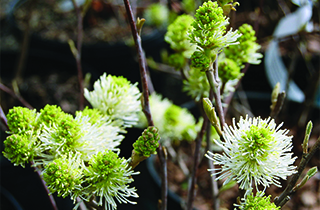A Plant For All Four Seasons

Gardeners are always looking for a “four seasons plant,” meaning a plant with one or more attractive characteristics in each of the four seasons. Dwarf Fothergilla, Fothergilla gardenii, and large Fothergilla, Fothergilla major, along with Fothergilla x intermedia hybrids all fit this description.
THESE FOTHERGILLAS HAVE FOUR CONSISTENTLY EXCELLENT CHARACTERISTICS: beautiful spring flowers, sturdy or leathery medium-green foliage in summer, spectacular fall color, and a beautiful, organized shape in winter. This makes these shrubs perfect four-seasons plants.
FOTHERGILLAS PREFER WELL-DRAINED SOIL, and when planted in a grouping, they may sucker and form a beautiful, dense mass. Most often, though, they are planted singly or in pairs. The flowers are 1 to 2 inches, white, and roundish or shaped like a bottlebrush. They emerge in spring just before the leaves. The heavily veined leaves turn a variety of vibrant colors in the fall. You may see red, purple, yellow, and orange leaves all on the same plant.
‘BLUE SHADOW’ FOTHERGILLA IS A LITTLE DIFFERENT in that its summer foliage is blue to blue-green. While Fothergillas can grow in full sun to part shade, Blue Shadow is best planted in part shade where it will have better blue leaf color. Of the blue-leaved forms, Blue Shadow is also known for its fall color. Without its blue summer foliage, Blue Shadow is difficult to distinguish from other Fothergillas.
DWARF FOTHERGILLA IS THE MOST POPULAR of the species, with its vigorous cousin Fothergilla x intermedia ‘Mt Airy’ being the next most commonly available form. The blue forms like Blue Shadow are always harder to find.
SHELLY NOLD is a horticulturist and owner of The Plant Kingdom. Send stories and ideas to her at The Plant Kingdom, 4101 Westport Road, Louisville, KY 40207.
ASK THE GARDENER
by Angie McManus
Q: Something is eating the berries off my pyracantha bush during the night. I am fairly certain it is not deer, there are no tracks around the bush. What bird or animal will eat the berries? Normally the berries will last all winter for the catbirds to feed on.
A: There are several varieties of pyracantha (firethorn); they range in growth habit, but all are evergreen and produce various shades of bright yellow, orange-red berries. When it comes to food for animals, it is hard to say what is going to be eaten first during the colder months when food is less abundant. Depending on environmental conditions during the growing season, some favorites among birds and other animals may not have produced as well and so wildlife is forced to choose food that is otherwise saved for last.
I would also doubt that the deer are eating these highly ornamental berries, because they are considered deer-resistant. Nothing is deer-proof, but I would suspect birds to be the culprit. Pyracantha is a favorite among a variety of birds, including Northern mockingbirds and cedar waxwings.
Have a Gardening Question?
Ask the Gardener

